back to db page
Ranger dV2 Possibilities
Imagine all of these various ways of
building the same basic rifle. Then, imagine picking ONE to introduce
to people and to field test.
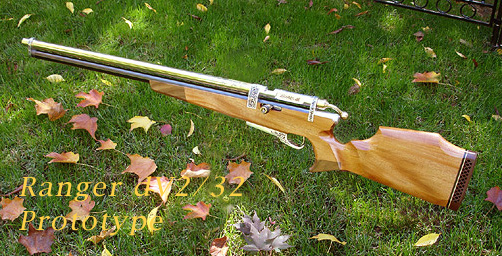 I did. I made this one.
Here are, however; quite a few other
possible formats. I've done the Photoshop work - in order
that you do not have to imagine.
I did. I made this one.
Here are, however; quite a few other
possible formats. I've done the Photoshop work - in order
that you do not have to imagine.
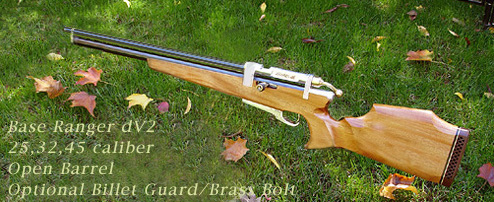
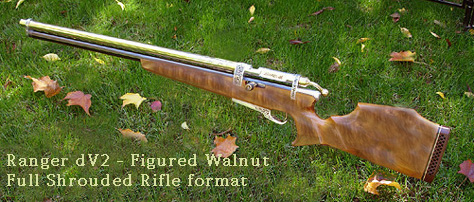
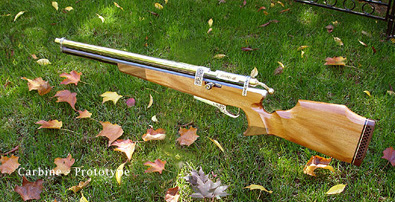
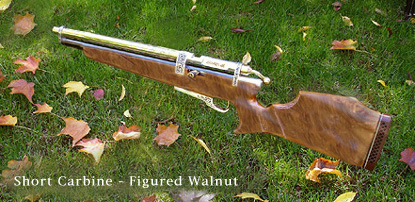
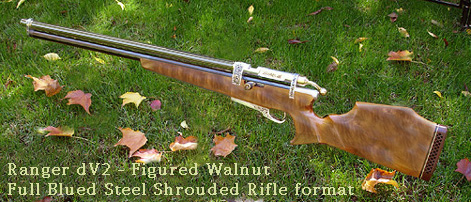
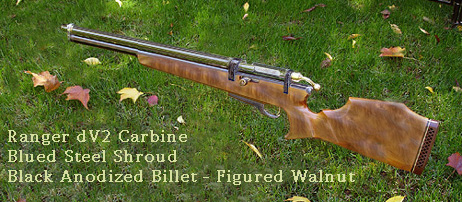
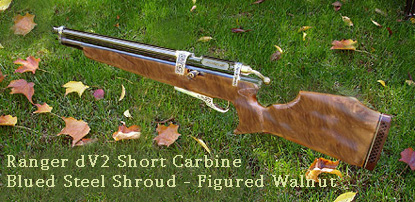
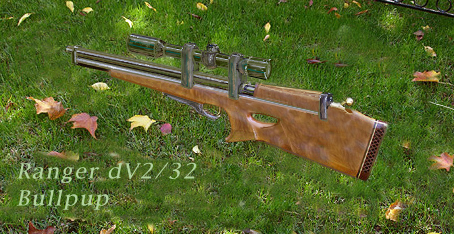 OK ... now you need to know what each
possible version weighs, what's the power range of each, how many
shots do each get? And, what does each cost ... with the mix and
match options listed.
No problem.
Let's start. We'll go thru the logic
- the reasons things work as they do. A quick, short price grid
would be nice - but it would not answer the hundred questions
that apply. Once we absorb the "why" for various formats
... I will post a price grid. Annoying, isn't it? If I don't do
it this way, I'll have to cover all of this material a single
e-mail at a time ... all the while trying to "undo"
initial misconceptions.
I put together a sort of "Gary's
Choice" of options for the Prototype you've seen ... and
which I've tested. Some customers have joked with me that ...
surely, since this series is new ... I've found a way to ignore
physics ... and probably make these in a tenth of the time. ;?)
I guess you know the responce.
The Prototype is a full rifle ... and
it's shrouded. That brings the total length of the whole package
to 50" ... which fits inside a standard $29 rifle case. It
duplicates the specs. of the Ranger Delta Base model, is lighter,
and gets more shots. It's also shrouded, which so many people
want.
I chose a medium density Mahogany for
the stock ... dressed it up alittle with walnut caps (which could
also be relief carved). That prototype stock weighs 3 pounds.
Hold it (without the action) and it feels weightless. Still -
it's three pounds.
Now ... realize that's already half
of what the super weight conscious buyer says he wants. That would
mean that I'd have to make the entire steel action within another
3 pounds. Isn't going to happen. The action I made weighs 5.5
pounds. We're at 8.5 total.
Alright ... let's just drop down to
the short carbine (much more handy ya know). Shed some weight
maybe ... and, let's get that figured walnut stock. Now we're
talking!
OK ... let's see
what we've done by making a Short Carbine.
We reduced the overall length to a
nice compact 35" OAL.
We took the stock from 3 pounds to
6 pounds instantly. Figured woods are far more heavy.
And, we bought an additional $800 stock
blank/build cost as well.
"We cut back some steel though
- right?" Only the stuff out in the middle of the tube which
weighs far less. It's the end caps and the valves which weigh
up. We still need those same components. We've just dropped a
few inches of empty tubing.
We kept the barrel shrouded ... that
requires a chamber in front of the actual muzzle (to catch the
muzzle wash - which comes out "in front" of the muzzle)
so, the interior "actual barrel" is now about 9 3/4"
from transfer port to actual muzzle. We have to keep the trigger
to butt pad length the standard (approx. 14 1/2") for human
usage. All we have to trim is the front, if we are going to shorten
the rifle.
That took our power potential from
116 fpe to about 40-50 fpe for a balanced format for this short
version. The actual barrel is now shorter than the Victory Pistol/Carbine
or Appaloosa Class.
If you'd want to run the shorty carbine
with an open barrel - that would give us some barrel length back.
Maybe another 20 fpe to boot. But it would give no more air reservoir
back. It would just transfer length from sound chamber length
to solid barrel - within the same overall length.
Since the pressure reservoir can't
hang out way beyond the barrel, we've reduced that to match. This
has reduced our air storage capacity by alittle more than half.
That will cut our shots per charge, by more than half - since
we've dramatically altered how the reservoir works.
Air usage "efficiency" is
now out the window. We have to "hot rod" the shots now.
That means we kick the slug in the butt with TOO MUCH air, in
order to get any velocity at all. We use the same amount of air
that was making 116 fpe thru a long barrel, in order to make about
a quarter of that much in our short barrel. That's too much air
for the short PCP barrel to use efficiently. Now, after the slug
is gone, the residual of that initial blast is just wasted exiting
the barrel in a raw blast.
That means the whole gun is also more
noisy now - even shrouded.
How about the
Carbine Length then?
Well, we can add back about five or
six inches. If we go to an open barrel ... the reality is we also
gain back the interior shroud chamber length as well. That gives
us back more yet. But ... no shroud. You note the BASE model Full
Rifle with the open barrel(about 45" OAL) is a good bit shorter
than the Full Rifle which is shrouded. However ... in that shrouded
version ... we use the space under the shroud to continue the
reservoir ... giving us max. storage capacity.
In the Carbine, if we remain shrouded
- we net maybe another 5-6 inches over the shorty carbine's barrel
and reservoir. We'll most likely be in the 75 fpe range now with
the shrouded carbine. We still net less air in the Carbine than
the prototype. But - we have our total gun to about 40-41 inches.
Convert shroud length to solid barrel
in the Carbine format (meaning loose the shroud), and I'd guess
you get back another 10-15 fpe or so. efficiency depends upon
how HOT you run the rifle. As you "hot it up" ... you
loose efficiency. You loose balance as well. You get a couple
of hot shots, then you refill. No five shot groups from a fill.
Sorry.
OK ... wait .. we haven't said anything
about a FAT RESERVOIR! That's the ticket. We keep the gun short
- get more air ... right?
Well, you also keep the barrel short
- loose power and efficiency. Mainly - you add weight because
the fatter reservoir (greater diameter) now has vastly greater
interior wall surface per diameter. That requires a much thicker
wall material to contain the same pressure. The smaller diameter
1" reservoir, in quality chrome moly seamless extruded steel
tubing, requires less wall thickness. Gives a very efficient air
storage per weight per foot.
Nuts.
Well, I want a light
weight gun. I want it shrouded - I need it quiet. I want significant
power. I want a "big bore" caliber with readily available
and economical ammo. I want as many shots as I can get per fill.
I want it air efficient with a balanced shot group. I want it
to hold and point well. I want it to show well at the range. It
must have superior accuracy to boot!
Oh ... then you need
the Prototype - that's why I built that one.
You know .. you can't get thru the
woods with a rifle that's too long now. You know....?
Actually, you need to decide it you
are really going to be crawling thru brush and stuff with your
custom rifle. Come to think of it ... when people really HAD to
go to the woods ...
Daniel Boone, Davy Crockett, the guns
were vastly longer than our 50" gun. Kentucky Rifle, Brown
Bess musket ... ;?) Many antique big bore airguns had barrels
alone that were 40-48" Check it out.
Well ... why is everything else shorter
today?
You mean like ... 20 fpe FT rifles?
You mean like unshrouded open barrel PCPs? Or maybe PCP's producing
half the power? Or firearms, which are not airguns at all?
So: you're saying
there's no place for carbines or short carbines?
I'm not saying that
at all!
You recall seeing my entire Victory
Class? How about the Appaloosa?
They're highly developed and shown in detail. Have been publicly
demonstrated extensively. Produce about 60-80 fpe. Very efficient
with air. Deadly accurate. Designed to efficiently use readily
available buckshot ball, as well as custom slugs. The carbines
are already here. If you like this stock better - that version
of the dV2 would be a very similar gun to a Victory carbine. With
a little longer scope rail and rear receiver clamp.
I'm offering you what you want. I'm
just not lying to you in order to tell folks what they want to
hear. ;?) Please don't loose sight of the fact that we're talking
AIR guns. The laws of physics apply. You can't make the Yukon
in the Victory package. ;?)
Well, let's address
this weight thing.
OK ... I've engineered billet aluminum
components everywhere suitable. "But ... blued steel is so
nice". That's fine ... only weighs several times as much
and is not required for the many tasks. There are plenty of components
made from several alloys of steel - where required - all can be
blued. "Engineering" is choosing the correct material
for the task ... and designing that material so that it will serve
it's intended purpose safely and efficiently.
"Well, we want everything black".
Fine ... I'll anodize the billet for you ... aluminum is white.
"But ... anodizing costs". That's correct.
Our mahogany stock (at 3 pounds) is
already something we need to work around. Double that weight with
figured wood, and it's completely unrealistic to expect a light
weight rifle to result. We love figured woods. So - we need to
learn to love weight too. My custom machined action can't be the
only thing that the weight limit applies to. ;?)
You can shoot open barrel guns at a
range, where noise is no problem. If you wish a shrouded design;
it's going to weigh more, cut down barrel length, increase the
gun's total length, and cost alittle more. I've shown you my best
compromise suggestion.
Let's address
the "Classic Firearm Look" thing.
That's just fine ... for firearms.
Nothing about a PCP applies to a firearm. A firearm has no pressure
reservoir, no intake valve, no firing valve. Uses a tiny little
hammer action to tap the firing pin. It's gold fish and gerbils.
You can't make a good gerbil that looks exactly like a gold fish.
;?)
Well, it would seem
we've done the impossible! Designed an efficient, good looking
PCP rifle that shoots marvelous, uses inexpensive (easy to acquire)
ammo, has great power, excellent accuracy, is quiet, is light
weight, holds well, takes a full sized scope well ... and is 100%
handmade as well. That's exactly how I'd have done it myself!
;?)
OK ... now you need to know what each
possible version weighs, what's the power range of each, how many
shots do each get? And, what does each cost ... with the mix and
match options listed.
No problem.
Let's start. We'll go thru the logic
- the reasons things work as they do. A quick, short price grid
would be nice - but it would not answer the hundred questions
that apply. Once we absorb the "why" for various formats
... I will post a price grid. Annoying, isn't it? If I don't do
it this way, I'll have to cover all of this material a single
e-mail at a time ... all the while trying to "undo"
initial misconceptions.
I put together a sort of "Gary's
Choice" of options for the Prototype you've seen ... and
which I've tested. Some customers have joked with me that ...
surely, since this series is new ... I've found a way to ignore
physics ... and probably make these in a tenth of the time. ;?)
I guess you know the responce.
The Prototype is a full rifle ... and
it's shrouded. That brings the total length of the whole package
to 50" ... which fits inside a standard $29 rifle case. It
duplicates the specs. of the Ranger Delta Base model, is lighter,
and gets more shots. It's also shrouded, which so many people
want.
I chose a medium density Mahogany for
the stock ... dressed it up alittle with walnut caps (which could
also be relief carved). That prototype stock weighs 3 pounds.
Hold it (without the action) and it feels weightless. Still -
it's three pounds.
Now ... realize that's already half
of what the super weight conscious buyer says he wants. That would
mean that I'd have to make the entire steel action within another
3 pounds. Isn't going to happen. The action I made weighs 5.5
pounds. We're at 8.5 total.
Alright ... let's just drop down to
the short carbine (much more handy ya know). Shed some weight
maybe ... and, let's get that figured walnut stock. Now we're
talking!
OK ... let's see
what we've done by making a Short Carbine.
We reduced the overall length to a
nice compact 35" OAL.
We took the stock from 3 pounds to
6 pounds instantly. Figured woods are far more heavy.
And, we bought an additional $800 stock
blank/build cost as well.
"We cut back some steel though
- right?" Only the stuff out in the middle of the tube which
weighs far less. It's the end caps and the valves which weigh
up. We still need those same components. We've just dropped a
few inches of empty tubing.
We kept the barrel shrouded ... that
requires a chamber in front of the actual muzzle (to catch the
muzzle wash - which comes out "in front" of the muzzle)
so, the interior "actual barrel" is now about 9 3/4"
from transfer port to actual muzzle. We have to keep the trigger
to butt pad length the standard (approx. 14 1/2") for human
usage. All we have to trim is the front, if we are going to shorten
the rifle.
That took our power potential from
116 fpe to about 40-50 fpe for a balanced format for this short
version. The actual barrel is now shorter than the Victory Pistol/Carbine
or Appaloosa Class.
If you'd want to run the shorty carbine
with an open barrel - that would give us some barrel length back.
Maybe another 20 fpe to boot. But it would give no more air reservoir
back. It would just transfer length from sound chamber length
to solid barrel - within the same overall length.
Since the pressure reservoir can't
hang out way beyond the barrel, we've reduced that to match. This
has reduced our air storage capacity by alittle more than half.
That will cut our shots per charge, by more than half - since
we've dramatically altered how the reservoir works.
Air usage "efficiency" is
now out the window. We have to "hot rod" the shots now.
That means we kick the slug in the butt with TOO MUCH air, in
order to get any velocity at all. We use the same amount of air
that was making 116 fpe thru a long barrel, in order to make about
a quarter of that much in our short barrel. That's too much air
for the short PCP barrel to use efficiently. Now, after the slug
is gone, the residual of that initial blast is just wasted exiting
the barrel in a raw blast.
That means the whole gun is also more
noisy now - even shrouded.
How about the
Carbine Length then?
Well, we can add back about five or
six inches. If we go to an open barrel ... the reality is we also
gain back the interior shroud chamber length as well. That gives
us back more yet. But ... no shroud. You note the BASE model Full
Rifle with the open barrel(about 45" OAL) is a good bit shorter
than the Full Rifle which is shrouded. However ... in that shrouded
version ... we use the space under the shroud to continue the
reservoir ... giving us max. storage capacity.
In the Carbine, if we remain shrouded
- we net maybe another 5-6 inches over the shorty carbine's barrel
and reservoir. We'll most likely be in the 75 fpe range now with
the shrouded carbine. We still net less air in the Carbine than
the prototype. But - we have our total gun to about 40-41 inches.
Convert shroud length to solid barrel
in the Carbine format (meaning loose the shroud), and I'd guess
you get back another 10-15 fpe or so. efficiency depends upon
how HOT you run the rifle. As you "hot it up" ... you
loose efficiency. You loose balance as well. You get a couple
of hot shots, then you refill. No five shot groups from a fill.
Sorry.
OK ... wait .. we haven't said anything
about a FAT RESERVOIR! That's the ticket. We keep the gun short
- get more air ... right?
Well, you also keep the barrel short
- loose power and efficiency. Mainly - you add weight because
the fatter reservoir (greater diameter) now has vastly greater
interior wall surface per diameter. That requires a much thicker
wall material to contain the same pressure. The smaller diameter
1" reservoir, in quality chrome moly seamless extruded steel
tubing, requires less wall thickness. Gives a very efficient air
storage per weight per foot.
Nuts.
Well, I want a light
weight gun. I want it shrouded - I need it quiet. I want significant
power. I want a "big bore" caliber with readily available
and economical ammo. I want as many shots as I can get per fill.
I want it air efficient with a balanced shot group. I want it
to hold and point well. I want it to show well at the range. It
must have superior accuracy to boot!
Oh ... then you need
the Prototype - that's why I built that one.
You know .. you can't get thru the
woods with a rifle that's too long now. You know....?
Actually, you need to decide it you
are really going to be crawling thru brush and stuff with your
custom rifle. Come to think of it ... when people really HAD to
go to the woods ...
Daniel Boone, Davy Crockett, the guns
were vastly longer than our 50" gun. Kentucky Rifle, Brown
Bess musket ... ;?) Many antique big bore airguns had barrels
alone that were 40-48" Check it out.
Well ... why is everything else shorter
today?
You mean like ... 20 fpe FT rifles?
You mean like unshrouded open barrel PCPs? Or maybe PCP's producing
half the power? Or firearms, which are not airguns at all?
So: you're saying
there's no place for carbines or short carbines?
I'm not saying that
at all!
You recall seeing my entire Victory
Class? How about the Appaloosa?
They're highly developed and shown in detail. Have been publicly
demonstrated extensively. Produce about 60-80 fpe. Very efficient
with air. Deadly accurate. Designed to efficiently use readily
available buckshot ball, as well as custom slugs. The carbines
are already here. If you like this stock better - that version
of the dV2 would be a very similar gun to a Victory carbine. With
a little longer scope rail and rear receiver clamp.
I'm offering you what you want. I'm
just not lying to you in order to tell folks what they want to
hear. ;?) Please don't loose sight of the fact that we're talking
AIR guns. The laws of physics apply. You can't make the Yukon
in the Victory package. ;?)
Well, let's address
this weight thing.
OK ... I've engineered billet aluminum
components everywhere suitable. "But ... blued steel is so
nice". That's fine ... only weighs several times as much
and is not required for the many tasks. There are plenty of components
made from several alloys of steel - where required - all can be
blued. "Engineering" is choosing the correct material
for the task ... and designing that material so that it will serve
it's intended purpose safely and efficiently.
"Well, we want everything black".
Fine ... I'll anodize the billet for you ... aluminum is white.
"But ... anodizing costs". That's correct.
Our mahogany stock (at 3 pounds) is
already something we need to work around. Double that weight with
figured wood, and it's completely unrealistic to expect a light
weight rifle to result. We love figured woods. So - we need to
learn to love weight too. My custom machined action can't be the
only thing that the weight limit applies to. ;?)
You can shoot open barrel guns at a
range, where noise is no problem. If you wish a shrouded design;
it's going to weigh more, cut down barrel length, increase the
gun's total length, and cost alittle more. I've shown you my best
compromise suggestion.
Let's address
the "Classic Firearm Look" thing.
That's just fine ... for firearms.
Nothing about a PCP applies to a firearm. A firearm has no pressure
reservoir, no intake valve, no firing valve. Uses a tiny little
hammer action to tap the firing pin. It's gold fish and gerbils.
You can't make a good gerbil that looks exactly like a gold fish.
;?)
Well, it would seem
we've done the impossible! Designed an efficient, good looking
PCP rifle that shoots marvelous, uses inexpensive (easy to acquire)
ammo, has great power, excellent accuracy, is quiet, is light
weight, holds well, takes a full sized scope well ... and is 100%
handmade as well. That's exactly how I'd have done it myself!
;?)
 Prices asap. They will be in keeping
with all of my work.
Prices asap. They will be in keeping
with all of my work.










